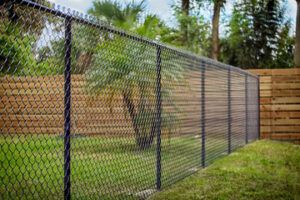Many options are available, whether you choose a decorative or practical metal fence. Most metal fences are made of aluminum or tubular steel. The advantages of these materials include their lighter weight and ease of installation. They can also be purchased in complete panels, making the process even more convenient. Additionally, aluminum and steel fences are less expensive to produce and install. The following are some of the different types of metal fences available. The pros and cons of each type are briefly discussed.
 Before installing the metal fence, make sure you have marked your property’s perimeter with spray paint. Then, drive masonry stakes and stretch a string between them. Mark the position of your fence posts with the string and ensure correct spacing. Once you know this, you can cut your fence panels to fit the gaps. Professional Fencing will save you a lot of time and effort. After all, it’s worth the effort.
Before installing the metal fence, make sure you have marked your property’s perimeter with spray paint. Then, drive masonry stakes and stretch a string between them. Mark the position of your fence posts with the string and ensure correct spacing. Once you know this, you can cut your fence panels to fit the gaps. Professional Fencing will save you a lot of time and effort. After all, it’s worth the effort.
Metal fences can come in different types, depending on your desired look and level of detail. Some fences use hollow parts to hide fasteners, while others use solid panels that need concrete posts. While installing metal fences, remember to adhere to local safety codes and make sure that the fasteners are concealed. If you don’t have the right experience or expertise, you can call professionals to do the job for you.
Chain-link fencing is one of the simplest and cheapest types of metal fences. It is not as decorative as other options but is good for containing pets and children. It is also very flexible and can be installed around unusual property lines. In addition, it is resistant to corrosion. For all these reasons, many homeowners choose this type of metal fence. However, the maintenance of a metal fence depends on the material used to make it and on your region’s climate.
To install a metal fence, you must first install the posts. You can install them with the help of masonry screws. Once you have installed the posts, you can attach the rails. You can then attach the panels to the posts. After that, you can choose whether to use a preassembled panel or a DIY kit. Aluminum fencing is typically lighter than steel, so you will not have to spend a lot of time installing it.
The next step is to apply a protective coating. Unlike plastic fences, metal fences should be coated to prevent rust and other elements from damaging them. You can use an oil-based primer that is specially formulated for metal. Make sure that you apply two coats of paint to the metal fence, so that it is completely protected.
Aluminum and steel are two of the most popular metal materials for ornamental metal fences. Although steel is more expensive, it offers low maintenance and is recyclable. In addition, they are both lightweight, durable and corrosion-resistant. Aluminum is also 100% recyclable, making them an excellent option for a seaside property. There are many different types of metal fences available to suit your needs.
Steel and wrought iron fences are similar in appearance and strength, and both can last for decades. When choosing a metal fencing for your property, consider the style and color you’d like. Steel fencing is beautiful and classic, while wrought iron fencing offers an elegant and versatile look. You should decide between the two options based on how much you want your fence to be and how durable you want it to be.
Metal fencing is typically sold in rolls of twenty or fifty feet and can be installed easily. Each roll can be joined by unscrewing the wire on the ends. Its height can range from three to eight feet, but the fence can be customized to suit your needs. The mesh is usually nine or eleven-wire gauge, and the length varies depending on what you need.
Aluminum fencing is the most economical form of metal fencing. It is lightweight, easy to install, and can be designed to look decorative. It is also completely maintenance-free. However, it is not as durable as steel and is not recommended for security gates or commercial fencing. It is also more susceptible to rust, making it unsuitable for security-conscious premises.
Metal fences can come in different types, depending on your desired look and level of detail. Some fences use hollow parts to hide fasteners, while others use solid panels that need concrete posts. While installing metal fences, remember to adhere to local safety codes and make sure that the fasteners are concealed. If you don’t have the right experience or expertise, you can call professionals to do the job for you.
